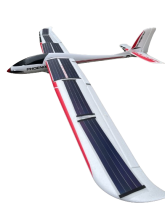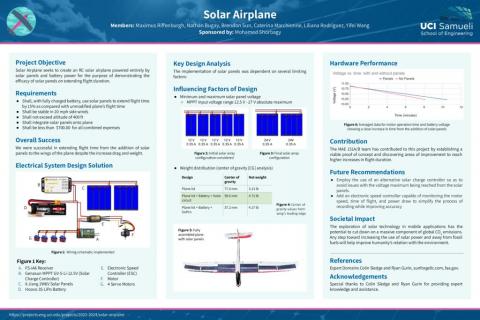Solar Airplane
Background
Our team embarked on a mission to revolutionize the world of hobbyist RC aircraft by developing a solar-powered airplane. Inspired by the growing interest in renewable energy and sustainable technologies, we saw an opportunity to merge aviation with innovative solar technology. Our project represents a fusion of traditional RC aircraft hobbyism with sustainable energy solutions, showcasing the potential for environmentally friendly innovations in the aviation industry.
Goal and Objectives
The project aims to acquire a fully functioning RC airplane model kit and integrate solar panels and an MPPT charge controller to maximize power generation to extend flight time. With a full battery, on a sunny day, our goal is to extend the flight time of an RC plane by 15% with the addition of solar panels as compared to that same RC plane flying without panels. We've meticulously designed the electrical system to ensure reliability and efficiency during flight operations.
Our team began in the Fall quarter of 2023, and by the end of the Winter quarter of 2024, the team aims to have successfully completed a fully functioning RC solar airplane with the following design requirements:
- Must extend flight time by 15%
- Must be stable in side winds of 20 mph
- Must not exceed the altitude of 400 feet during flight
- Must integrate solar panels
- Must not exceed the budget of $700
Objectives:
- Past Objectives:
- Research existing glider models and select the most suitable one for modification. (Completed by Fall Quarter 2023)
- Conduct test flights without solar panels to evaluate the performance and endurance of the airplane on battery power alone. (Completed Week 6 of Winter Quarter 2024)
- Present Objective: Mount solar panels onto the wings of the selected glider and integrate the necessary electrical components. (Ongoing, to be completed by Week 8 of Winter Quarter 2024)
- Future Objective: Conduct test flights with the solar panels integrated to evaluate the performance and endurance of the solar-powered airplane. (Planned for Week 9 of Winter Quarter 2024)
More Information
The assembly of the plane included the following parts:
- RC plane kit: Volantex RC Phoenix 2400
- Battery: Hoovo 3S 11.1V 2200mAh
- Remote Controller: FS-i6 2.4Ghz Radio System RC Transmitter
- Receiver: FS-iA6 Receiver
The assembly of the solar panels onto the plane included the following parts:
- Solar Panels: Jiang Flexible Thin Film
- Solar Charge Controller: GV-5-Li-12.5V
- Adhesive: Beacon Foam Tac Powerful Glue
Team Work Breakdown
Electrical Subteam:
The Electrical Subteam was tasked with selecting the most suitable solar panels, MPPT charge controller, and battery for our project. This involved extensive research and evaluation to ensure compatibility and efficiency. Additionally, they were responsible for determining the optimal solar configuration that maximizes power output while maintaining proper weight distribution and staying within the MPPT compatibility ranges. The team also meticulously wired the solar panels together and integrated them seamlessly into the original circuitry of the model, ensuring smooth operation and efficient power management during flight.
Members
- Maximus RiffenBurgh (mriffenb@uci.edu)
- Liliana Rodriguez (liliar@uci.edu)
Manufacturing Subteam:
The Manufacturing Subteam played a pivotal role in assessing the expected flight performance of our solar-powered airplane. They calculated the anticipated flight time both without and with solar panels, using fundamental aerodynamics principles and mathematical modeling. Additionally, the Manufacturing Subteam was responsible for attaching the solar panels to the wings of the airplane ensuring proper alignment and aerodynamic efficiency.
- Brendon Han (brendosh@uci.edu)
- Caterina Marchionne (cmarchio@uci.edu)
Physics Subteam:
The Physics Subteam played a critical role in ensuring the stability and performance of our solar-powered airplane. They primarily focused on calculating the Center of Gravity (CG) to maintain proper balance and stability during flight. Additionally, the Physics Subteam utilized Computer-Aided Design (CAD) software to model the airplane, allowing for a detailed analysis of solar panel placement.
Members
- Nathan Bugay (bugayn@uci.edu)
- Yifei Wang (yifeiw36@uci.edu)
Link to documentation
Final Design Binder: https://docs.google.com/document/d/1shVXHTdVFV-Z-4hS9zZKWQTs5J10NUHWE7oN...
Team Drive: https://drive.google.com/drive/folders/1vLSUp33aFsTjKVWHyJeVRLH-lJSq_o-6
Team Contact
Team Lead: Maximus Riffenburgh (mriffenb@uci.edu)
Sponsor/Advisor
Mohamed Shorbagy (mohamem2@uci.edu)


